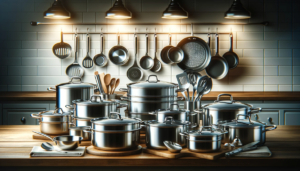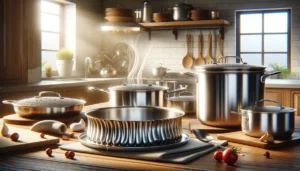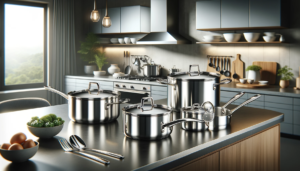Has your stainless steel cookware lost its luster after months in the kitchen? Proper care keeps it looking new, avoiding scratches and warping.
Caring for stainless steel cookware only requires following basic guidelines for cleaning, use, storage and periodic restoration.
Let’s dive into the key things you need to do to keep stainless steel pots and pans in good working order for the long haul.
How to Care for Stainless Steel Cookware?
Caring for stainless steel cookware revolves around proper cleaning, preventing damage during use, maintaining the exterior finish, storing pots and pans correctly, and occasionally reconditioning the cooking surface.
In short, HANDLE your stainless steel cookware with care by being mindful of abrasive cleaners, metal utensils, high heat, harsh scrubbing, and improper storage that could lead to scratches, warping, discoloration or corrosion over time.
We’ll explore each of these care principles more below, outlining specific maintenance tips to help keep your stainless steel looking and performing like new for as long as possible.
Proper Cleaning

Stainless steel is durable, but it still requires some care and attention to keep it looking nice.
The first rule is to avoid abrasive scouring pads when cleaning stainless steel pans.
Using steel wool or other rough scrubbers can actually scratch and damage the surface over time.
For day-to-day cleaning, wash stainless steel cookware by hand or in the dishwasher using a mild dish soap.
Harsh cleaners like bleach or ammonia should also be avoided, as they can react with the steel and cause corrosion or pitting.
Always be sure to rinse stainless steel thoroughly after washing to remove any residual soap or cleaning chemicals.
It is also important to dry the cookware fully with a soft towel rather than letting it air dry.
This helps prevent water spots or mineral deposits from building up on the surface.
Taking a minute to hand dry your stainless steel cookware helps keep the finish looking brand new.
Preventing Damage
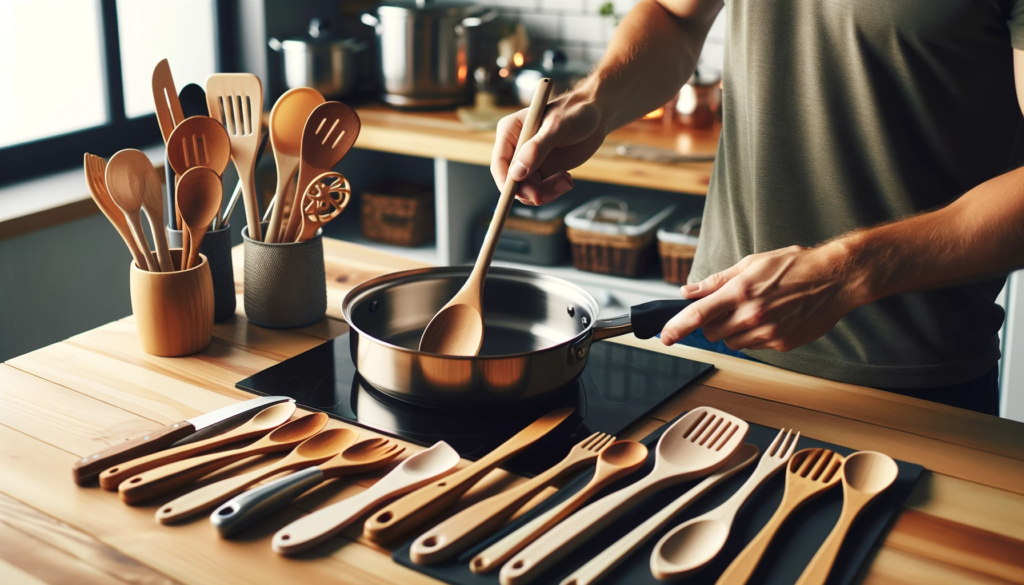
Although stainless steel is resistant to corrosion and rust, it is still susceptible to some types of damage with improper care.
Following a few simple guidelines will help prevent nicks, warping, or alteration of the surface finish.
When cooking with stainless steel, it is best to use wood, silicone or plastic cooking utensils rather than harsh metal utensils.
Scrambling eggs or stirring sauces with a hard metal fork or spoon can actually scratch and degrade the cooking surface over time.
This not only damages the appearance but can also make the pan more likely to stick or develop stubborn spots.
Be careful to never leave stainless steel cookware empty over high heat.
The metal can quickly overheat, which can cause warping or discoloration.
If preheating an empty pan, do so at a moderate temperature and don’t step away for long periods while it heats.
Handles and lids should also be kept clear of direct high heat, as these thinner pieces of metal are vulnerable to melting or loosening over time.
Finally, refrain from using abrasive scrubbers or harsh cleaners that might scratch or scour the interior cooking surface.
Stainless steel should never be scraped or gouged, even to remove stubborn dried food or grease.
This damages the smooth cooking surface, making it harder to clean and maintain going forward.
Maintaining the Finish
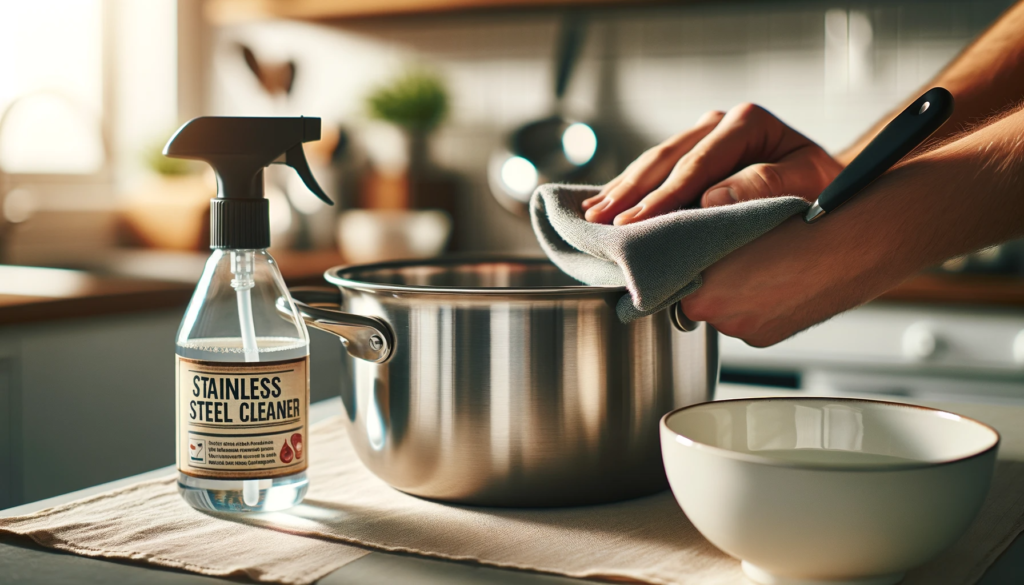
While stainless steel keeps its shiny appearance with regular cleaning, some care is required to maintain the finish at its best.
If water spots, mineral deposits or residue appear, there are a few simple ways to address these problems.
White vinegar is a handy product that helps dissolve stuck-on residue or hard water stains.
Allowing pans to soak for a bit in diluted vinegar can help restore the cookware’s clean sheen.
For tougher spots, gently rub the affected area with a soft cloth soaked in vinegar.
Remember to always rinse thoroughly after using any cleaning agents on stainless steel.
Alternatively, you can purchase commercial stainless steel cleaners and polishes that are formulated to dissolve residue without damaging the finish.
Apply a small amount to the surface according the product directions, gently rub with a soft cloth, then rinse and dry thoroughly.
Repeat as needed for stubborn spots to avoid damaging the pan.
To help maintain the stainless steel’s shine and prevent new water spots, consider occasionally treating the surface with olive oil or vegetable oil.
A thin coating creates a protective layer that repels water and guards against streaks and stains.
Simply rub a small amount of oil over the surface with a soft towel or paper towel, then thoroughly wipe away any excess.
This seasoning treatment can restore the cookware’s luster while protecting the steel itself from corrosion.
If your stainless steel pots and pans have lost some of their former shine, professional polishing services may be warranted to restore the original beauty of the metal.
While costly, a thorough professional cleaning and polishing can make lackluster cookware look brand new again by removing etching, scratches and oxidation that build up over years of use.
Storing Properly
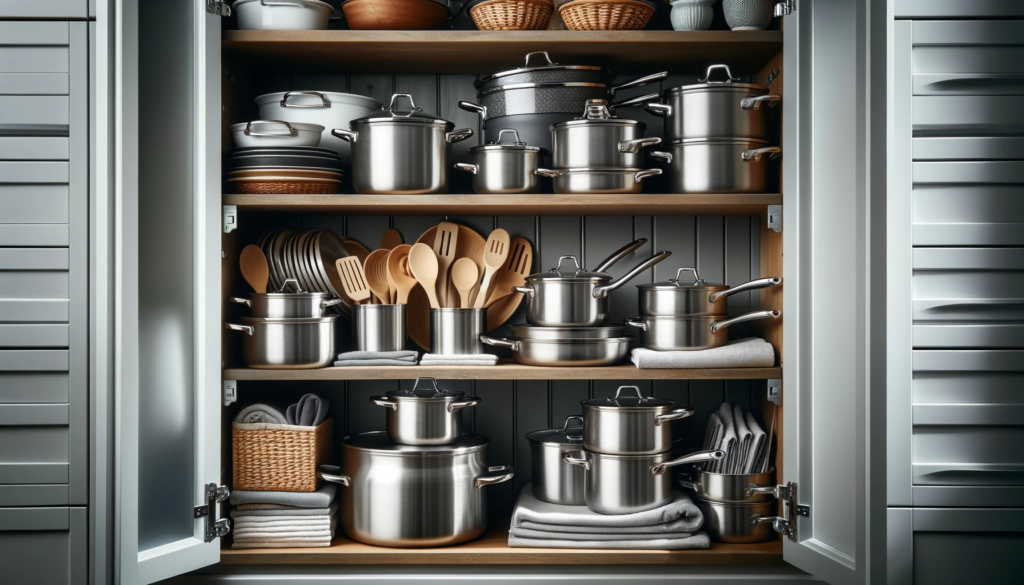
The way stainless steel cookware is cared for between uses can also have an impact on its longevity and performance.
Allowing pans to cool completely after cooking before putting them into storage is important to avoid potential warping from residual heat.
Dropping a very hot pan into water for quick cooling can damage the metal or weaken handles over time.
Storing cookware improperly can also lead to dents, scratches and misshapen pieces.
Whenever possible, pans should be laid flat rather than stacked when not in use.
If cabinet space is limited, hanging pots and pans is another organizing strategy to protect the metal surfaces while not in use.
If stacking is unavoidable due to space constraints, line pots and pans with kitchen towels to cushion them and prevent damaging scratches.
When to Reseason

While stainless steel doesn’t require actual seasoning like cast iron or carbon steel pans, the cooking surface can benefit from occasional restoration to prevent sticking or permanently embedded stains.
Over time, the patina of your stainless steel cookware will likely darken or discolor from the high heats of cooking.
If debris becomes burnt onto the surface or food starts stubbornly sticking, it may be time for a deep clean and reconditioning.
To restore the slick cooking properties of damaged stainless steel, first use a baking soda paste to gently scour the interior.
Create a thick paste from water and baking soda, then use a soft cloth or non-abrasive scrub sponge to loosen residue without scratching the metal.
Rinse thoroughly and make sure to fully dry the pan.
Once cleaned of debris, pour a small amount of vegetable, corn or grapeseed oil onto a paper towel and apply the thin oil coating onto the interior surface.
Take care to fully wipe away any drips or excess pooling with a clean towel.
This oil seasoning will help restore the pan’s non-stick properties while protecting the underlying steel.
With proper day-to-day care and occasional restoration as needed, quality stainless steel cookware should provide many years of reliable service in the kitchen.
Paying attention to prevent scratches, warping and permanent staining is the key to enjoying durable, resilient stainless pans and pots.
Follow these tips for cleaning, storage, and maintenance and your stainless steel cookware will stay in top performing condition for generations to come!
Conclusion
Caring for stainless steel cookware may seem complicated, but simply requires attention to cleaning, storage, and periodic restoration.
With proper maintenance, your stainless steel pots and pans can deliver excellent performance and lasting beauty for years of cooking enjoyment.
Treat them with care and you’ll be rewarded with durable, resilient cookware for everyday cooking tasks.

